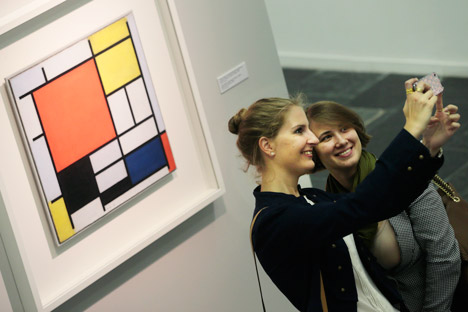
After visiting the exhibition people can say they know the roots of modern design. Source: ITAR-TASS
"We have the most extensive collection of works by Mondrian," says the director of the Hague museum, Benno Tempel. "Recently, there was a large project with the Centre Georges Pompidou and the Museum Lenbachhaus in Munich. But the exhibition in the Tretyakov Gallery surpasses them. Here, Mondrian is presented in a dialogue with the other two fathers of the avant-garde—Wassily Kandinsky and Kazimir Malevich—whose works are on permanent display in the gallery. These artists changed modern art itself and attitudes toward it. "
Later works by the Dutch artist had a huge impact on modern art. However, there are very few of the most recognizable Mondrian paintings on exhibit. Four paintings from 1920-1930, with classical perpendicular lines and color planes, are the highlights of the exhibit. One of the works, “Composition with Four Yellow Lines,” is echoed in a photograph, where the artist himself is depicted, as if explaining his canvas.
Besides his paintings, Mondrian also left a theoretical heritage. He explained his research in the field of neo-plasticism—the artist's name for his style—in an essay. "To not be interested in form or color—that is neo-plasticism," wrote Mondrian. "One should be interested only in relationships, creating them, and finding harmony in art and in life."
Despite the interest in his later replicated works, they are not the main feature of the exhibition. Organizers wanted to show the different stages in the creative evolution of the artist, and this approach, it appears, is popular with museum visitors.
Anna, one of the visitors, describes her impressions: "For me, the most unexpected was that they showed the whole journey of the artist. It becomes clear that, in his quest, the great experimenter tried different directions before he found himself and became the artist we know."
It begins with the earliest landscapes from the 1890-1900s, in which one can feel how deeply rooted Mondrian was in classic Dutch art, with its realist tradition. Yet, even in these works, a feature appears that is so important for the artist—the mandatory relationships between the horizontal (the water's edge, or a line of trees) and the vertical (trees, mills) in the canvas space. This is the theme that Mondrian developed throughout his entire life.
Later, Mondrian experimented with the major "-isms" of the 20th century. In the exhibition you can see his reaction to impressionism (“The Lighthouse in Westkapelle in Pink”), pointillism (“Little House in the Sunlight,” “A Church in Domburg”) and expressionism (“Piety,” “Portrait of a Girl,” “The Red Mill”).
The main movement, however, that helped him make the transition to abstraction was cubism. He was introduced to the paintings of Picasso and Braque at an exhibition in Amsterdam in 1911. Mondrian was so taken with them that, a year later, he created his Paris series of cubist works, which are presented in the exhibition.
Petersburg’s Trinity Bridge becomes a movie screen
Dutch exhibition revives memory of Peter the Great's European tour
"Some of these paintings remind me of designs on textiles and utensils from IKEA," says Mikhail, one of the visitors. "Now we know the roots of modern design. It's amazing how the idea of a genius penetrates into the daily life of an ordinary person."
Two other paintings are unexpected in the exhibition. One is “Pieta,” which shows Mondrian's skill as a classical painter. Another is a self-portrait from 1918—the period when the artist came close to abstractionism. In this painting, one of the geniuses of the 20th century gives us a stern look from a nearly monochrome canvas.
Mondrian was a person whose work influenced not only artists, but also designers, architects and printers. He was a master whose work, as fate would have it, is not in any Russian collection.
The “Piet Mondrian - The Path to Abstraction” exhibition will run through the end of November. For more information visit the webiste of The Tretyakov Gallery.
All rights reserved by Rossiyskaya Gazeta.
Subscribe
to our newsletter!
Get the week's best stories straight to your inbox